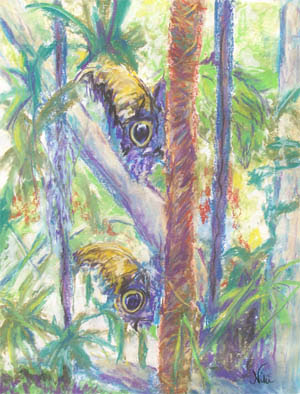Beauty in Hiding (How to use chalk pastels and water)
 "Beauty in Hiding" 18 x 24 Chalk Pastel on Paper
"Beauty in Hiding" 18 x 24 Chalk Pastel on PaperOriginal Sold
When most people think of chalk pastel, they don't think of brushes and water. Chalk pastel is in fact quite water soluble, if you know work carefully and adjust for the dust.
The piece above was based on a reference photo of butterflies at a seasonal exhibit. These particular butterflies have unique camouflage, with large shapes on the wings resembling (to me at least) owl eyes. The trick for this piece was to showcase the butterflies in all their camouflage glory without losing them in the background. I also wanted to work large. Using Canson watercolor paper, I utilized the following steps to achieve the end result (the work in progress photos are unfortunately darker because I took them at night):
 Stage one: using chalk pastels, I drew in my composition and blocked in lights and darks on taped down watercolor paper (this exercise does not work on paper made for dry pastels! Flat canvas works nicely though.) I left plenty of white paper to keep some lights in the next stage. There were a lot of hanging vertical plant pieces in the photo, so I tried to keep them loose enough not to close off any of the space in the painting.
Stage one: using chalk pastels, I drew in my composition and blocked in lights and darks on taped down watercolor paper (this exercise does not work on paper made for dry pastels! Flat canvas works nicely though.) I left plenty of white paper to keep some lights in the next stage. There were a lot of hanging vertical plant pieces in the photo, so I tried to keep them loose enough not to close off any of the space in the painting. Stage 2: I used a large watercolor brush and gently placed small amounts of water onto sections of the painting, spreading it around to fill in forms and shadows, being careful to leave a few lights along the way. This creates a different effect than smearing dry pastel does, in that the water fixes the medium to the paper and creates its own texture depending on how it combines with the chalk. One warning: the chalk tends to bubble up when you add water, thanks to the dust. I usually take these little "bubbles" and poke them around and spread them on the paper to see the effects. Adding just a tiny bit of water at a time will lessen the amound of bubbles; you can also try using less chalk on the paper, so that it combines more easily with the water.
Stage 2: I used a large watercolor brush and gently placed small amounts of water onto sections of the painting, spreading it around to fill in forms and shadows, being careful to leave a few lights along the way. This creates a different effect than smearing dry pastel does, in that the water fixes the medium to the paper and creates its own texture depending on how it combines with the chalk. One warning: the chalk tends to bubble up when you add water, thanks to the dust. I usually take these little "bubbles" and poke them around and spread them on the paper to see the effects. Adding just a tiny bit of water at a time will lessen the amound of bubbles; you can also try using less chalk on the paper, so that it combines more easily with the water. Stage 3: To finish the piece, I waited until the next day to make sure the piece was completely dry. (Do NOT try to add more chalk to your wet paper, or you risk ending up with ripped paper.) Once the piece is dry, it has the feel of a nice underpainting, with the chalk fairly fixed in place. This is a good stage to add those lights on top of darks, sharper edges, and in general emphasize any bright colors or bold strokes you want to add as a finishing touch.
Stage 3: To finish the piece, I waited until the next day to make sure the piece was completely dry. (Do NOT try to add more chalk to your wet paper, or you risk ending up with ripped paper.) Once the piece is dry, it has the feel of a nice underpainting, with the chalk fairly fixed in place. This is a good stage to add those lights on top of darks, sharper edges, and in general emphasize any bright colors or bold strokes you want to add as a finishing touch. Chalk pastel is a versatile medium; in those times when I feel like using both my hands and a brush to create, the water and chalk combination works perfectly for me.
Here are is another piece I created using water and chalk pastel on paper:
 "Ladies of the Water" 9 x 12 Chalk Pastel on Paper (original sold, prints available here: http://www.redbubble.com/people/nikihilsabeck/art/5833876-ladies-of-the-water)
"Ladies of the Water" 9 x 12 Chalk Pastel on Paper (original sold, prints available here: http://www.redbubble.com/people/nikihilsabeck/art/5833876-ladies-of-the-water)Click here to see more of my botanical and garden-themed art for sale!



Comments
Post a Comment